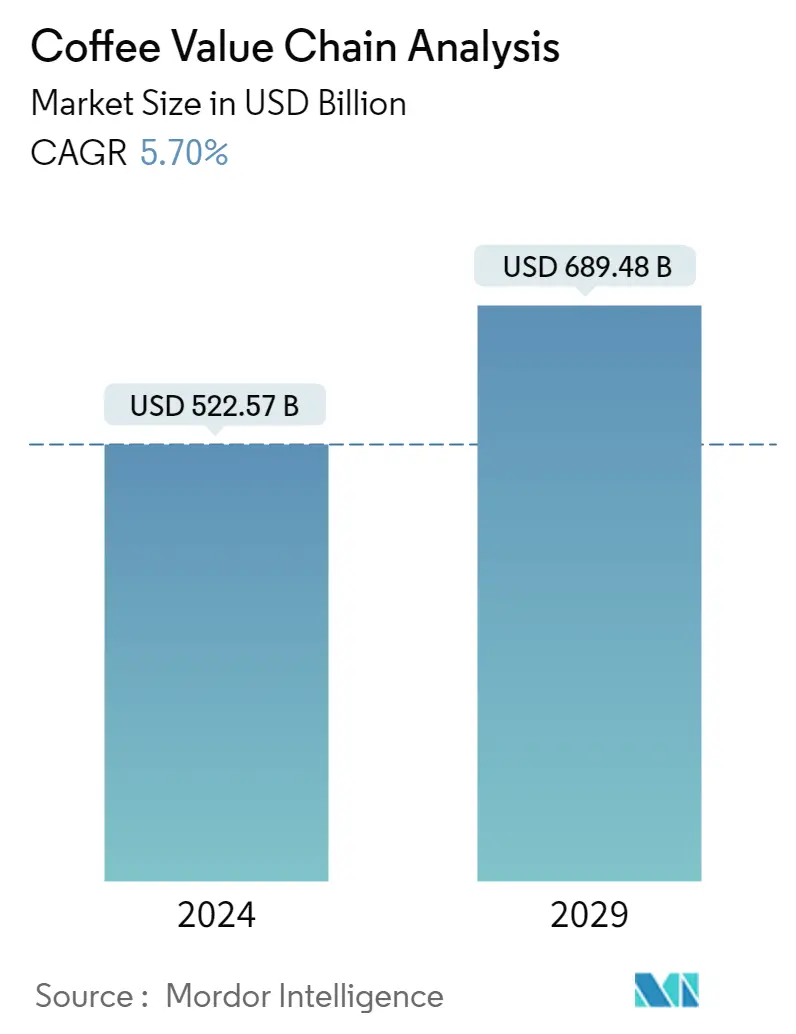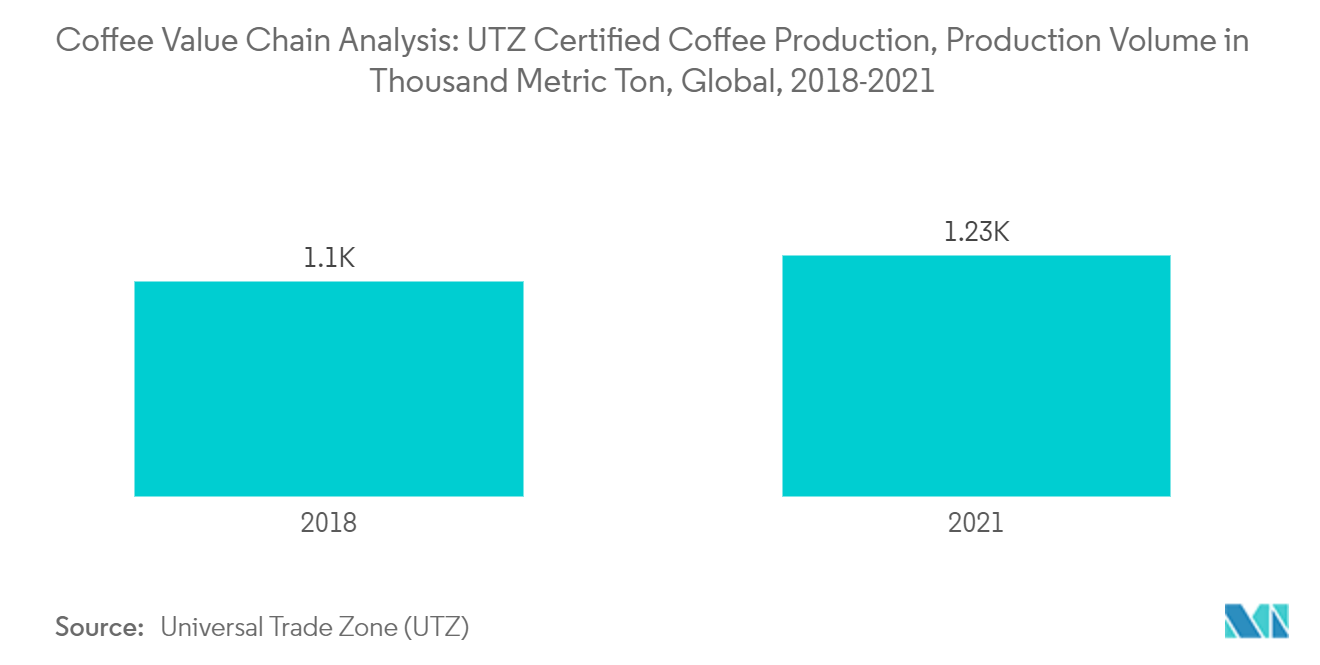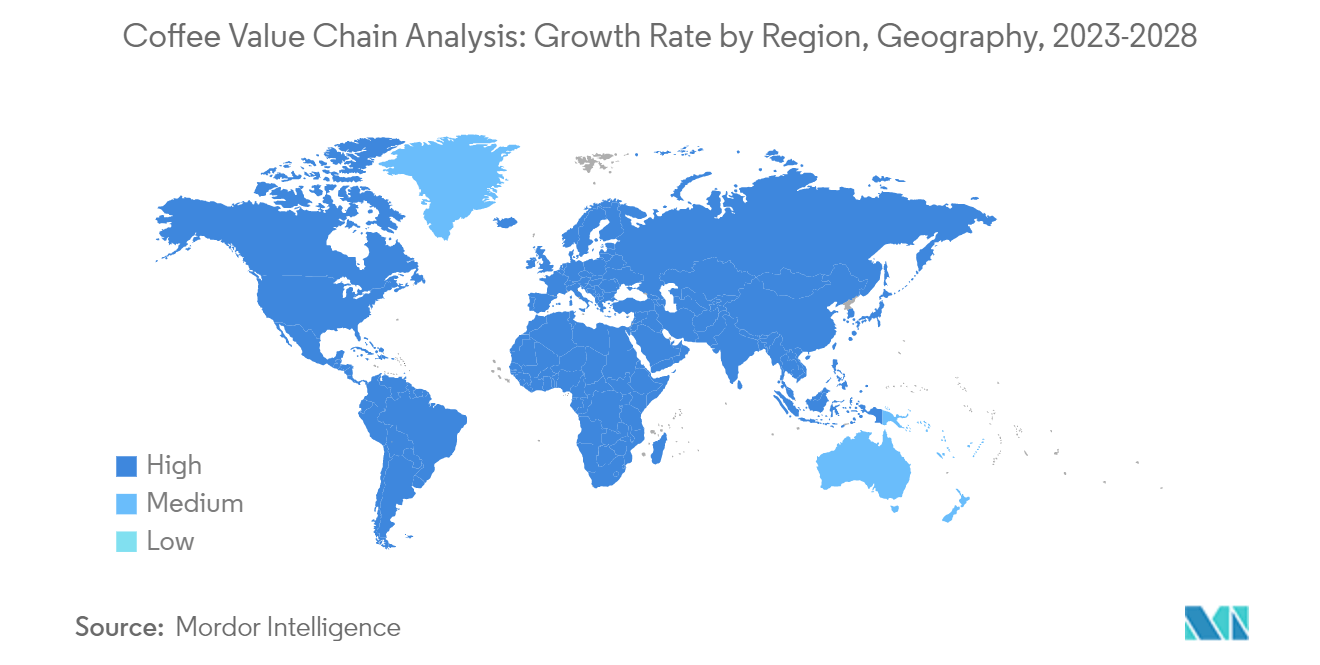Coffee Value Chain Market Size

| Study Period | 2019 - 2029 |
| Base Year For Estimation | 2023 |
| Forecast Data Period | 2024 - 2029 |
| Market Size (2024) | USD 522.57 Billion |
| Market Size (2029) | USD 689.48 Billion |
| CAGR (2024 - 2029) | 5.70 % |
Major Players*Disclaimer: Major Players sorted in no particular order |
Coffee Value Chain Market Analysis
The Coffee Market size is estimated at USD 522.57 billion in 2024, and is expected to reach USD 689.48 billion by 2029, growing at a CAGR of 5.70% during the forecast period (2024-2029).
- Coffee is produced in more than 50 developing countries in South America, Africa, and Asia and is an essential source of income for more than 20-25 million families worldwide. The initial production of coffee beans is highly labor intensive. It involves several labor-intensive activities, such as farming, collecting, and processing. Hence, these activities are performed in labor-abundant countries. However, roasting and branding are capital-intensive activities in the coffee supply chain and are therefore situated in the northern industrialized countries. The structure of the value chain is very similar to producing as well as consuming countries. The coffee value chain comprises four main phases: cultivation, processing, roasting, and consumption. Each step in the process has environmental, social, economic, and governance issues that affect the future sustainability of extracting coffee beans.
- On the consumer front, the promotion of coffee by the government, coupled with investment in R&D by major companies, is expected to stimulate the market's growth during the forecast period. For instance, In April 2022, Lulu Hypermarket in the Kingdom of Saudi Arabia, in cooperation with the Ministry of Culture, launched the Year of Saudi Coffee 2022, a great promotion meant to draw attention to the culinary and cultural significance of Saudi-grown coffee beans and it's unique traditional and symbolism as a marker of Saudi hospitality.
- However, the coffee industry has various issues, from farms to markets, such as poor labor practices, unfair wages, deforestation, air pollution from roasting plants, and irregular pricing of coffee, acting as a barrier to the market.
Coffee Value Chain Market Trends
This section covers the major market trends shaping the Coffee Value Chain Market according to our research experts:
Surge in Demand for Certified Coffee Products
Considerable growth has occurred in certified coffee, especially in fair trade coffee, in major countries globally. The development comes from consumer concerns related to social, environmental, and health impacts associated with the production and distribution of coffee. Sustainable certifications allow consumers to express preferences for a more just and healthier environment with daily purchases of essential commodities, like coffee.
Due to rising consumer concerns regarding the sourcing and quality of coffee, the demand for certified coffee is increasing globally. Certified coffee is an assurance to the consumer about the product's reliability. These certifications offer various third-party guarantees to the consumer regarding environmental-friendly farming practices and the quality involved during the production of coffee due to rising consumer concerns regarding the sourcing and quality of coffee.
Several coffee certification organizations are checking coffee's production procedures and supply chain. Some of them are Fair Trade Certification, Rainforest Alliance Certification, UTZ Certification, and USDA Organic Certification. These certifications help to improve the quality of life of workers and help to gain adequate market access through increased trade of certified coffee.
Among all the certifications, UTZ Certification or the rainforest alliance is necessary, allowing the farmers to grow coffee professionally with care for local communities and the environment. The most important aspect of the UTZ certification program is traceability, which means that consumers can know exactly where their coffee comes from and how it was produced. This makes consumers more inclined toward purchasing certified coffee, fueling the market's growth during the forecast period.

Brazil Dominates the Production of Coffee
Brazil is appropriately nestled in the tropical zone, which is highly suitable for the production of coffee. According to a database published by United Nations Food and Agriculture Organization (FAO), coffee production in Brazil stood at 3.01 million metric ton in 2019 and it has increased to 22.9% in 2020 (3.70 million metric ton). The total area under coffee harvest in Brazil was recorded at 1,825,283 and 1,898,239 hectares for 2019 and 2020 respectively.
Furthermore, as per the ITC Trade map, Brazil was the largest exporter of coffee in the year 2021 accounting for 2,288,336 metric ton, followed by Vietnam, Burkina Faso, Colombia, and Germany respectively.
The country is a true powerhouse of coffee production. Brazil produces nearly 40% of the world's coffee supply and has been a key player in the global coffee market since time immemorial. Furthermore, many areas in Brazil have a climate perfectly conducive to coffee farming. Coffee plantations cover about 27,000 square kilometers of Brazil, with the majority located in Minas Gerais, Sao Paulo, and Parana. The country has also been witnessing a territorial shift from a concentrated production in the mountainous Minas region in the Southeast to the Central warmer Cerrado region in recent years. The harvest period ranges from April to September, as the temperature is optimal for the cultivation of coffee beans during this period.

Coffee Value Chain Market News
- December 2022: The US Government, through the US Agency for International Development (USAID), launched the Indonesia Coffee Enterprise Resilience Initiative (Resilient Coffee) to support coffee farmers in Indonesia.
- October 2022: Nestle commits over USD 1 Billion to a sustainable coffee farming plan. The brand plans to improve the sustainability of coffee farming and help farmers transition to regenerative agriculture practices.
- July 2022: The central government of India proposed a new 'Coffee (Promotion and Development Bill), 2022' to promote the development of the Indian coffee industry.
Coffee Value Chain Market Report - Table of Contents
1. INTRODUCTION
- 1.1 Study Assumptions and Market Definition
- 1.2 Scope of the Study
2. RESEARCH METHODOLOGY
3. EXECUTIVE SUMMARY
4. Supply Chain Analysis
- 4.1 Supply Chain Structure
- 4.2 Stakeholders in the Supply Chain
- 4.3 Issues with Supply Chain Structure
5. Value Chain Analysis
- 5.1 Value Chain Structure
- 5.2 Price Markups in the Value Chain
- 5.3 Stakeholders in the Value Chain
- 5.4 Issues with Value Chain Structure
6. MARKET OPPORTUNITIES AND FUTURE TRENDS
** Subject To AvailablityCoffee Value Chain Industry Segmentation
Coffee beans are small dark-brown beans roasted and ground to make coffee. The scope of the report considers the value chain of raw coffee beans. The report covers a detailed supply chain analysis and value chain analysis of the coffee industry at a global level. A typical coffee value chain system involves the operation of five major segments: coffee bean production, sourcing and trading, marketing, processing, distribution, and retailing to the final consumers. Stakeholders across the value chain, the price margin at each stakeholder level, and issues prevalent in the coffee value chain are also provided in the report.
Coffee Value Chain Market Research FAQs
How big is the Coffee Market?
The Coffee Market size is expected to reach USD 522.57 billion in 2024 and grow at a CAGR of 5.70% to reach USD 689.48 billion by 2029.
What is the current Coffee Market size?
In 2024, the Coffee Market size is expected to reach USD 522.57 billion.
What years does this Coffee Market cover, and what was the market size in 2023?
In 2023, the Coffee Market size was estimated at USD 494.39 billion. The report covers the Coffee Market historical market size for years: 2019, 2020, 2021, 2022 and 2023. The report also forecasts the Coffee Market size for years: 2024, 2025, 2026, 2027, 2028 and 2029.
Coffee Value Chain Industry Report
Statistics for the 2024 Coffee Value Chain market share, size and revenue growth rate, created by Mordor Intelligence™ Industry Reports. Coffee Value Chain analysis includes a market forecast outlook to 2029 and historical overview. Get a sample of this industry analysis as a free report PDF download.



